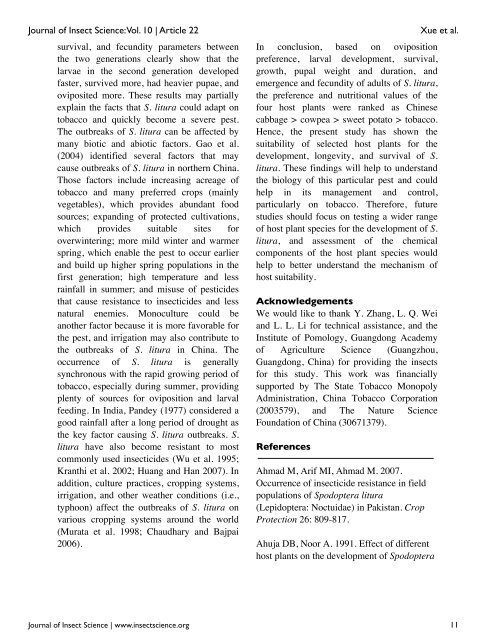Effects of four host plants on biology and food utilization - Journal of ...
Effects of four host plants on biology and food utilization - Journal of ...
Effects of four host plants on biology and food utilization - Journal of ...
You also want an ePaper? Increase the reach of your titles
YUMPU automatically turns print PDFs into web optimized ePapers that Google loves.
<strong>Journal</strong> <str<strong>on</strong>g>of</str<strong>on</strong>g> Insect Science: Vol. 10 | Article 22<br />
survival, <strong>and</strong> fecundity parameters between<br />
the two generati<strong>on</strong>s clearly show that the<br />
larvae in the sec<strong>on</strong>d generati<strong>on</strong> developed<br />
faster, survived more, had heavier pupae, <strong>and</strong><br />
oviposited more. These results may partially<br />
explain the facts that S. litura could adapt <strong>on</strong><br />
tobacco <strong>and</strong> quickly become a severe pest.<br />
The outbreaks <str<strong>on</strong>g>of</str<strong>on</strong>g> S. litura can be affected by<br />
many biotic <strong>and</strong> abiotic factors. Gao et al.<br />
(2004) identified several factors that may<br />
cause outbreaks <str<strong>on</strong>g>of</str<strong>on</strong>g> S. litura in northern China.<br />
Those factors include increasing acreage <str<strong>on</strong>g>of</str<strong>on</strong>g><br />
tobacco <strong>and</strong> many preferred crops (mainly<br />
vegetables), which provides abundant <strong>food</strong><br />
sources; exp<strong>and</strong>ing <str<strong>on</strong>g>of</str<strong>on</strong>g> protected cultivati<strong>on</strong>s,<br />
which provides suitable sites for<br />
overwintering; more mild winter <strong>and</strong> warmer<br />
spring, which enable the pest to occur earlier<br />
<strong>and</strong> build up higher spring populati<strong>on</strong>s in the<br />
first generati<strong>on</strong>; high temperature <strong>and</strong> less<br />
rainfall in summer; <strong>and</strong> misuse <str<strong>on</strong>g>of</str<strong>on</strong>g> pesticides<br />
that cause resistance to insecticides <strong>and</strong> less<br />
natural enemies. M<strong>on</strong>oculture could be<br />
another factor because it is more favorable for<br />
the pest, <strong>and</strong> irrigati<strong>on</strong> may also c<strong>on</strong>tribute to<br />
the outbreaks <str<strong>on</strong>g>of</str<strong>on</strong>g> S. litura in China. The<br />
occurrence <str<strong>on</strong>g>of</str<strong>on</strong>g> S. litura is generally<br />
synchr<strong>on</strong>ous with the rapid growing period <str<strong>on</strong>g>of</str<strong>on</strong>g><br />
tobacco, especially during summer, providing<br />
plenty <str<strong>on</strong>g>of</str<strong>on</strong>g> sources for ovipositi<strong>on</strong> <strong>and</strong> larval<br />
feeding. In India, P<strong>and</strong>ey (1977) c<strong>on</strong>sidered a<br />
good rainfall after a l<strong>on</strong>g period <str<strong>on</strong>g>of</str<strong>on</strong>g> drought as<br />
the key factor causing S. litura outbreaks. S.<br />
litura have also become resistant to most<br />
comm<strong>on</strong>ly used insecticides (Wu et al. 1995;<br />
Kranthi et al. 2002; Huang <strong>and</strong> Han 2007). In<br />
additi<strong>on</strong>, culture practices, cropping systems,<br />
irrigati<strong>on</strong>, <strong>and</strong> other weather c<strong>on</strong>diti<strong>on</strong>s (i.e.,<br />
typho<strong>on</strong>) affect the outbreaks <str<strong>on</strong>g>of</str<strong>on</strong>g> S. litura <strong>on</strong><br />
various cropping systems around the world<br />
(Murata et al. 1998; Chaudhary <strong>and</strong> Bajpai<br />
2006).<br />
In c<strong>on</strong>clusi<strong>on</strong>, based <strong>on</strong> ovipositi<strong>on</strong><br />
preference, larval development, survival,<br />
growth, pupal weight <strong>and</strong> durati<strong>on</strong>, <strong>and</strong><br />
emergence <strong>and</strong> fecundity <str<strong>on</strong>g>of</str<strong>on</strong>g> adults <str<strong>on</strong>g>of</str<strong>on</strong>g> S. litura,<br />
the preference <strong>and</strong> nutriti<strong>on</strong>al values <str<strong>on</strong>g>of</str<strong>on</strong>g> the<br />
<str<strong>on</strong>g>four</str<strong>on</strong>g> <str<strong>on</strong>g>host</str<strong>on</strong>g> <str<strong>on</strong>g>plants</str<strong>on</strong>g> were ranked as Chinese<br />
cabbage > cowpea > sweet potato > tobacco.<br />
Hence, the present study has shown the<br />
suitability <str<strong>on</strong>g>of</str<strong>on</strong>g> selected <str<strong>on</strong>g>host</str<strong>on</strong>g> <str<strong>on</strong>g>plants</str<strong>on</strong>g> for the<br />
development, l<strong>on</strong>gevity, <strong>and</strong> survival <str<strong>on</strong>g>of</str<strong>on</strong>g> S.<br />
litura. These findings will help to underst<strong>and</strong><br />
the <strong>biology</strong> <str<strong>on</strong>g>of</str<strong>on</strong>g> this particular pest <strong>and</strong> could<br />
help in its management <strong>and</strong> c<strong>on</strong>trol,<br />
particularly <strong>on</strong> tobacco. Therefore, future<br />
studies should focus <strong>on</strong> testing a wider range<br />
<str<strong>on</strong>g>of</str<strong>on</strong>g> <str<strong>on</strong>g>host</str<strong>on</strong>g> plant species for the development <str<strong>on</strong>g>of</str<strong>on</strong>g> S.<br />
litura, <strong>and</strong> assessment <str<strong>on</strong>g>of</str<strong>on</strong>g> the chemical<br />
comp<strong>on</strong>ents <str<strong>on</strong>g>of</str<strong>on</strong>g> the <str<strong>on</strong>g>host</str<strong>on</strong>g> plant species would<br />
help to better underst<strong>and</strong> the mechanism <str<strong>on</strong>g>of</str<strong>on</strong>g><br />
<str<strong>on</strong>g>host</str<strong>on</strong>g> suitability.<br />
Acknowledgements<br />
We would like to thank Y. Zhang, L. Q. Wei<br />
<strong>and</strong> L. L. Li for technical assistance, <strong>and</strong> the<br />
Institute <str<strong>on</strong>g>of</str<strong>on</strong>g> Pomology, Guangd<strong>on</strong>g Academy<br />
<str<strong>on</strong>g>of</str<strong>on</strong>g> Agriculture Science (Guangzhou,<br />
Guangd<strong>on</strong>g, China) for providing the insects<br />
for this study. This work was financially<br />
supported by The State Tobacco M<strong>on</strong>opoly<br />
Administrati<strong>on</strong>, China Tobacco Corporati<strong>on</strong><br />
(2003579), <strong>and</strong> The Nature Science<br />
Foundati<strong>on</strong> <str<strong>on</strong>g>of</str<strong>on</strong>g> China (30671379).<br />
References<br />
Ahmad M, Arif MI, Ahmad M. 2007.<br />
Occurrence <str<strong>on</strong>g>of</str<strong>on</strong>g> insecticide resistance in field<br />
populati<strong>on</strong>s <str<strong>on</strong>g>of</str<strong>on</strong>g> Spodoptera litura<br />
(Lepidoptera: Noctuidae) in Pakistan. Crop<br />
Protecti<strong>on</strong> 26: 809-817.<br />
Ahuja DB, Noor A. 1991. Effect <str<strong>on</strong>g>of</str<strong>on</strong>g> different<br />
<str<strong>on</strong>g>host</str<strong>on</strong>g> <str<strong>on</strong>g>plants</str<strong>on</strong>g> <strong>on</strong> the development <str<strong>on</strong>g>of</str<strong>on</strong>g> Spodoptera<br />
Xue et al.<br />
<strong>Journal</strong> <str<strong>on</strong>g>of</str<strong>on</strong>g> Insect Science | www.insectscience.org 11

















